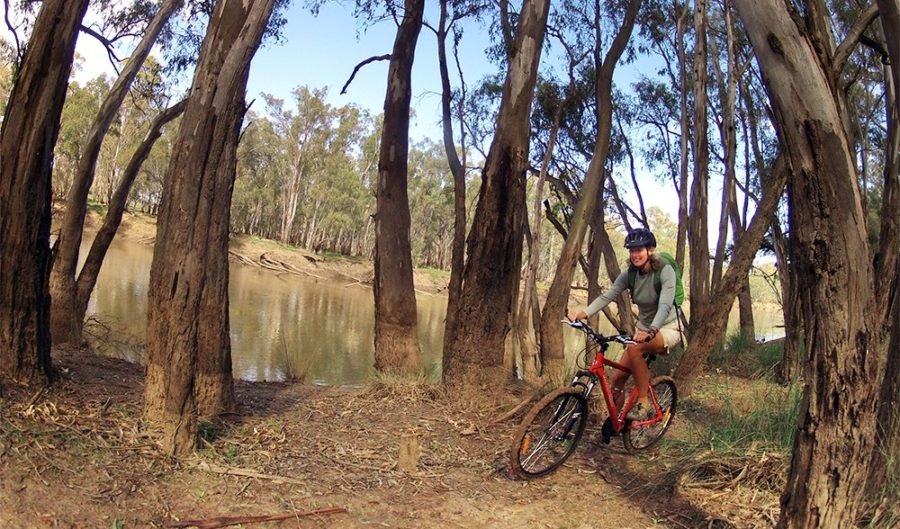Camping in Murrumbidgee National Park

IT TAKES A good half hour of dogged persistence. I’ve burnt almost a box of matches and am beginning to lament my lack of fire-making skills. When a flame finally catches hold in the damp firewood, I yelp for joy.
This is the first time I’ve had to light a fire – during years of camping in Australia I’ve always used my trusty hiking stove, as fires aren’t permitted in almost every national park. Except this one.
As I sit back and enjoy the fire’s mesmerising warmth, I appreciate this rare camping experience in Murrumbidgee Valley National Park.
History of Murrumbidgee Valley National Park
In country NSW, between Wagga Wagga and Griffith, Murrumbidgee Valley NP is one of Australia’s newest. It was created in July 2010, when more than 100,000ha of land along the Murray and Murrumbidgee rivers was gazetted.
From the late 1800s, for more than a century, this was a big logging area, says Dave Parker, project officer at the NSW Office of Environment and Heritage. After 1903, the area was owned by the Crown and managed by State Forests – for the main purpose of logging. “You can still see remnants of that time,” says David, referring to rusty logging equipment in the forest.
Because of the previous management set-up, locals have been able to collect firewood from the park (six tonnes per household per year for less than $30/t) and campers are able to enjoy camp fires. But now it’s a national park that may soon change.
The National Parks and Wildlife Service is realistic about weaning people off their firewood habits; a review of firewood collection and camp fires in the park is tabled for this year, David says.
Unlike many of Australia’s biodiverse national parks, the NSW Riverina is basically a monoculture, with river red gums dominating. Yellow box, black box, grey box and river oaks do sporadically occur.
But the red gums are the reason for the park status – Murrumbidgee Valley has Australia’s biggest continuous river red gum forest.
Camp facilities at Murrumbidgee Valley
The residual State Forests management gives the area a Wild West feel compared with most national parks. In addition to camp fires, you can have dogs (in some areas) and camp anywhere – for free.
But this means facilities are…shall we say…modest. There is the odd picnic table, but no toilets, running water or rubbish bins, so be prepared to take in all you need and take out all rubbish.
The park’s back-to-basics nature means fewer campers and a real bush experience – just you and the animals. In the early-morning fog, mobs of kangaroos may be seen munching on grass. Other marsupials – such as dunnarts, antechinus and gliders – also live here, as do 180 bird species, Dave says. Koalas are regularly seen in the eastern areas as they’ve multiplied at a great rate since being introduced into the Narrandera Nature Reserve in the mid-1970s.
Kayaking on the Murrumbidgee River
It’s damp all around because a few weeks before my visit the area copped its biggest flood in decades, making national news. The floodwater left its mark on the red gums stretching far back from the natural bank. “It’s like [the trees] had a bath after 50 years,” says Dave. At its highest, the Murrumbidgee peaked at 8.8m, turning much of the area into a temporary quagmire.
The Riverina region is no stranger to flooding – this ecosystem relies on regular flooding to flush it out and regenerate nutrients. But this flood was unusually high. “For these forests, the floods were amazing,” says Dave.
Regular minor flooding wouldn’t ordinarily affect camping in the park; in fact, kayaking is much more fun on a swollen Murrumbidgee River.
Kayaking is a popular outdoor pursuit in the Riverina. Though the Murrumbidgee (meaning “big water” in the Wiradjuri language) is one of Australia’s great rivers, stretching from the Snowy Mountains to the confluence of the Murray, this section is mostly flat water.
Journeying along this stretch of the Murrumbidgee is a relaxed affair – it’s more about floating than paddling. You can even turn around and paddle upstream with just a bit of effort.
The gentle current (in non-flooded times) allows for a meandering trip, giving you enough time to take in the scene and spot the koalas that often climb high up along branches leaning over the water.
It’s one of local guide Ian Hardie’s favourite areas. He moved to the Riverina about 30 years ago and recently started the only local tour company operating in the national park. He guides groups on kayaking, mountain biking and walking trips, and provides all gear.
Because good maps of the new park are hard to come by, it’s worth having a GPS if you plan on finding your own way around. Cross-country cycling is another way to explore. Most of the gentle off-road (mostly double-track) trails follow the same river kayakers paddle down, but there are plans to develop a network of singletrack mountain-bike trails over the next few years.
Visiting Murrumbidgee Valley National Park
Getting there: Fly to regional airport Narrandera-Leeton. Murrumbidgee Valley NP is a 10-minute drive from the airport. Checked luggage is limited to 15kg on REX regional flights. By car, Narrandera is five and a half hours north of Melbourne or four hours from Canberra.
Accommodation: There are no camping fees or designated sites. Wood fires are permitted (collect firewood in the park), but this will be phased out soon.
Getting around: Park maps are underdeveloped. There are dirt roads, so the fun is in exploring.
Activities: Kayaking, cycling, walking, camping.
Eco highlights: Wetland of international importance (Fivebough and Tuckerbil swamps); koala reserve; river red gum forest.
Tours: Riverina Experience,
www.riverinaexperience.com.au

